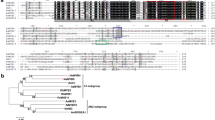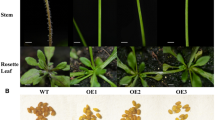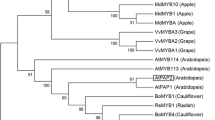Abstract
MrMYB1, an R2R3 MYB transcription factor (TF) gene associated with anthocyanin biosynthesis in Chinese bayberry (Myrica rubra Sieb. and Zucc.), was introduced into Arabidopsis and tobacco (Nicotiana tabacum) under the control of the CaMV 35S promoter. Overexpression of MrMYB1 induced anthocyanin accumulation in all tissues of Arabidopsis as well as in petals, ovaries and young seeds of tobacco, but not in tobacco leaves. The anthocyanin biosynthetic pathway, including chalcone synthase (CHS), dihydroflavonol 4-reductase (DFR) and anthocyanidin synthase (ANS), and the basic helix-loop-helix (bHLH) transcriptional partner TRANSPARENT TESTA8 (TT8), were up-regulated significantly in MrMYB1-overexpressing Arabidopsis. In MrMYB1-overexpressing tobacco petals, ovaries and young seeds, anthocyanin biosynthetic genes and bHLH partners NtAn1a and NtAn1b, were up-regulated. In contrast, high expression of MrMYB1 in transgenic tobacco leaves did not induce the expression of anthocyanin biosynthesis. Unlike in petals and ovaries, the foliar transcript level of NtAn1a and NtAn1b was extremely low and not stimulated by MrMYB1 transformation. These results show that higher expression of an endogenous bHLH partner, either intrinsically or stimulated by exogenous gene transformation, is required for anthocyanin production in plant tissues, and the different abundance in endogenous bHLH transcript accounts for differential accumulation of anthocyanin in Arabidopsis and tobacco leaves. These findings demonstrate that higher levels of expression of an endogenous bHLH partner, either intrinsically or following genetic transformation, are required for anthocyanin production in plant tissues. Moreover, differences in levels of endogenous bHLH transcripts account for observed differential accumulation of anthocyanin in leaves of Arabidopsis and tobacco.





Similar content being viewed by others
Abbreviations
- TF:
-
Transcription factor
- CaMV:
-
Cauliflower mosaic virus
- CHS:
-
Chalcone synthase
- DFR:
-
Dihydroflavonol 4-reductase
- ANS:
-
Anthocyanidin synthase
- bHLH:
-
Basic helix-loop-helix
- TT8:
-
TRANSPARENT TESTA8
- PAP1:
-
Production of Anthocyanin Pigment 1
- ANT1:
-
Anthocyanin1
- CDS:
-
Coding sequence
- RNR2:
-
Ribonucleotide reductase R2
- NPT II:
-
Neomycin phosphotransferase II
- HPLC:
-
High-performance liquid chromatography
- CTAB:
-
Cetyltrimethylammonium bromide
- qPCR:
-
Real-time quantitative PCR
- CHI:
-
Chalcone isomerase
- UFGT:
-
UDP-glucose: flavonoid 3-O-glucosyltransferase
References
Aharoni A, Ric De Vos CH, Wein M, Sun ZK, Greco R, Kroon A, Mol JNM, O’Connell AP (2001) The strawberry FaMYB1 transcription factor suppresses anthocyanin and flavonol accumulation in transgenic tobacco. Plant J 28:319–332
Allan AC, Hellens RP, Laing WA (2008) MYB transcription factors that colour our fruit. Trends Plant Sci 13:99–102
Bai Y, Pattanaik S, Patra B, Werkman JR, Xie CH, Yuan L (2011) Flavonoid-related basic helix-loop-helix regulators, NtAn1a and NtAn1b, of tobacco have originated from ancestors and are functionally active. Planta 234:363–375
Ban Y, Honda C, Hatsuyama Y, Igarashi M, Bessho H, Moriguchi T (2007) Isolation and functional analysis of a MYB transcription factor gene that is a key regulator for the development of red coloration in apple skin. Plant Cell Physiol 48:958–970
Baudry A, Caboche M, Lepiniec L (2006) TT8 control its own expression in feedback regulation involving TTG1 and homologous MYB and bHLH factors, allowing a strong and cell-specific accumulation of flavonoids in Arabidopsis thaliana. Plant J 46:768–779
Bogs J, Jaffé FW, Takos AM, Walker AR, Robinson SP (2007) The grapevine transcription factor VvMYBPA1 regulates proanthocyanidin synthesis during fruit development. Plant Physiol 143:1347–1361
Borevitz JO, Xia Y, Blount J, Dixon RA, Lamb C (2000) Activation tagging identifies a conserved MYB regulator of phenylpropanoid biosynthesis. Plant Cell 12:2383–2394
Butelli E, Titta L, Giorgio M, Mock HP, Matros A, Peterek S, Schijlen EGWM, Hall RD, Bovy AG, Luo J, Martin C (2008) Enrichment of tomato fruit with health-promoting anthocyanins by expression of select transcription factors. Nature Biotechnol 26:1301–1308
Chabouté M-E, Combettes B, Clément B, Gigot C, Philipps G (1998) Molecular characterization of tobacco ribonucleotide reductase RNR1 and RNR2 cDNAs and cell cycle-regulated expression in synchronized plant cells. Plant Mol Biol 38:797–806
Clough SJ, Bent AF (1998) Floral dip: a simplified method for Agrobacterium-mediated transformation of Arabidopsis thaliana. Plant J 16:735–743
Cutanda-Perez M-C, Ageorges A, Gomez C, Vialet S, Terrier N, Romieu C, Torregrosa L (2009) Ectopic expression of VlmybA1 in grapevine activates a narrow set of genes involved in anthocyanin synthesis and transport. Plant Mol Biol 69:633–648
Deluc L, Bogs J, Walker AR, Ferrier T, Decendit A, Merillon JM, Robinson RP, Barrieu F (2008) The transcription factor VvMYB5b contributes to the regulation of anthocyanin and proanthocyanidin biosynthesis in developing grape berries. Plant Physiol 147:2041–2053
Espley RV, Hellens RP, Putterill J, Stevenson DE, Kutty-Amma S, Allan AC (2007) Red colouration in apple fruit is due to the activity of the MYB transcription factor, MdMYB10. Plant J 49:414–427
Espley RV, Bovy A, Bava C, Jaeger SR, Tomes S, Norling C, Crawford J, Rowan D, McGhie TK, Brendolise C, Putterill J, Schouten HJ, Hellens RP, Allan AC (2012) Analysis of genetically modified red-fleshed apples reveals effects on growth and consumer attributes. Plant Biotechnol J. doi:10.1111/pbi.12017
Feller A, Machemer K, Braun EL, Grotewold E (2011) Evolutionary and comparative analysis of MYB and bHLH plant transcription factors. Plant J 66:94–116
Feng SQ, Wang YL, Yang S, Xu YT, Chen XS (2010) Anthocyanin biosynthesis in pears is regulated by a R2R3-MYB transcription factor PyMYB10. Planta 232:245–255
Feng C, Chen M, Xu CJ, Bai L, Yin XR, Li X, Allan AC, Ferguson IB, Chen KS (2012) Transcriptomic analysis of Chinese bayberry (Myrica rubra) fruit development and ripening using RNA-Seq. BMC Genomics 13:19
Gao JJ, Shen XF, Zhang Z, Peng RH, Xiong AS, Xu J, Zhu B, Zheng JL, Yao QH (2011) The myb transcription factor MdMYB6 suppresses anthocyanin biosynthesis in transgenic Arabidopsis. Plant Cell Tiss Organ Cult 106:235–242
Grotewold E (2006) The genetics and biochemistry of floral pigments. Annu Rev Plant Biol 57:761–780
Hellens RP, Allan AC, Friel EN, Bolitho K, Grafton K, Templeton MD, Karunairetnam S, Gleave AP, Laing WA (2005) Transient expression vectors for functional genomics, quantification of promoter activity and RNA silencing in plants. Plant Methods 1:13
Hichri I, Barrieu F, Bogs J, Kappel C, Delrot S, Lauvergeat V (2011) Recent advances in the transcriptional regulation of the flavonoid biosynthetic pathway. J Exp Bot 62:2465–2483
Holton T, Cornish E (1995) Genetics and biochemistry of anthocyanin biosynthesis. Plant Cell 7:1071–1083
Horsch RB, Fry JE, Hoffmann NL, Eichholtz D, Rogers SG, Fraley RT (1985) A simple and general method for transferring genes into plants. Science 227:1229–1231
Huang YJ, Yin XR, Zhu CQ, Wang WW, Grierson D, Xu CJ, Chen KS (2013) Standard addition quantitative real-time PCR (SAQPCR): a novel approach for determination of transgene copy number avoiding pcr efficiency estimation. PLOS ONE 8:e53489
Jin H, Martin C (1999) Multifunctionality and diversity within the plant MYB-gene family. Plant Mol Biol 41:577–585
Laitinen RAE, Ainasoja M, Broholm SK, Teeri TH, Elomaa P (2008) Identification of target genes for a MYB-type anthocyanin regulator in Gerbera hybrida. J Exp Bot 59:3691–3703
Lin-Wang K, Bolitho K, Grafton K, Kortstee A, Karunairetnam S, McGhie TK, Espley RV, Hellens RP, Allan AC (2010) An R2R3 MYB transcription factor associated with regulation of the anthocyanin biosynthetic pathway in Rosaceae. BMC Plant Biol 10:50
Lloyd AM, Walbot V, Davis RW (1992) Arabidopsis and Nicotiana anthocyanin production activated by maize regulators R and C1. Science 258:1773–1775
Mathews H, Clendennen SK, Caldwell CG, Liu XL, Connors K, Matheis N, Schuster DK, Menasco DJ, Wagoner W, Lightner J, Ry Wagner D (2003) Activation tagging in tomato identifies a transcriptional regulator of anthocyanin biosynthesis, modification, and transport. Plant Cell 15:1689–1703
Mooney M, Desnos T, Harrison K, Jones J, Carpenter R, Coen E (1995) Altered regulation of tomato and tobacco pigmentation genes caused by the delila gene of Antirrhinum. Plant J 7:333–339
Niu SS, Xu CJ, Zhang WS, Zhang B, Li X, Lin-Wang K, Ferguson IB, Allan AC, Chen KS (2010) Coordinated regulation of anthocyanin biosynthesis in Chinese bayberry (Myrica rubra) fruit by a R2R3 MYB transcription factor. Planta 231:887–899
Park JS, Kim JB, Cho KJ, Cheon CI, Sung MK, Choung MG, Roh KH (2008) Arabidopsis R2R3-MYB transcription factor AtMYB60 functions as a transcriptional repressor of anthocyanin biosynthesis in lettuce (Lactuca sativa). Plant Cell Rep 27:985–994
Pattanaik S, Kong Q, Zaitlin D, Werkman JR, Xie CH, Patra B, Yuan L (2010) Isolation and functional characterization of a floral tissue-specific R2R3 MYB regulator from tobacco. Planta 231:1061–1076
Paz-Ares J, Ghosal D, Wienand U, Peterson PA, Saedler H (1987) The regulatory c1 locus of Zea mays encodes a protein with homology to myb proto-oncogene products and with structural similarities to transcriptional activators. EMBO J 6:3553–3558
Quattrocchio F, Wing JF, van der Woude K, NM Mol J, Koes R (1998) Analysis of bHLH and MYB domain proteins: species-specific regulatory differences are caused by divergent evolution of target anthocyanin genes. Plant J 13:475–488
Quattrocchio F, Verweij W, Kroon A, Spelt C, Mol J, Koes R (2006) PH4 of petunia is an R2R3 MYB protein that activates vacuolar acidification through interactions with Basic-Helix-Loop-Helix transcription factors of the anthocyanin pathway. Plant Cell 18:1274–1291
Schwinn K, Venail J, Shang Y, Mackay S, Alm V, Butelli E, Oyama R, Bailey P, Davies K, Martin C (2006) A small family of MYB-regulatory genes controls floral pigmentation intensity and patterning in the genus Antirrhinum. Plant Cell 18:831–851
Shan LL, Li X, Wang P, Cai C, Zhang B, Sun CD, Zhang WS, Xu CJ, Ferguson IB, Chen KS (2008) Characterization of cDNAs associated with lignification and their expression profiles in loquat fruit with different lignin accumulation. Planta 227:1243–1254
Spelt C, Quattrocchio F, Mol JN, Koes R (2000) Anthocyanin1of petunia encodes a basic helix-loop-helix protein that directly activates transcription of structural anthocyanin genes. Plant Cell 12:1619–1632
Sun CD, Zheng YX, Tang XL, Jiang M, Zhang JK, Li X, Chen KS (2012a) Purification and anti-tumor activity of cyanidin-3-O-glucoside from Chinese bayberry fruit. Food Chem 13:1287–1294
Sun CD, Zhang B, Zhang JK, Xu CJ, Wu YL, Li X, Chen KS (2012b) Cyanidin-3-glucoside-rich extract from Chinese bayberry fruit protects pancreatic β cells and ameliorates hyperglycemia in streptozotocin-induced diabetic mice. J Med Food 15:288–298
Walker AR, Davison PA, Bolognesi-Winfield AC, James CM, Srinivasan N, Blundell TL, Esch JJ, Marks MD, Gray JC (1999) The Transparent Testa Glabra1 locus, which regulates trichome differentiation and anthocyanin biosynthesis in Arabidopsis, encodes a WD40 repeat protein. Plant Cell 11:1337–1350
Wang WW, Zhu CQ, Liu XH, Chen KS, Xu CJ (2011) Techniques for rapid preparation of tomato leaf DNA and its application in real-time quantitative PCR-based transgene detection. Hereditas (Beijing) 33:1017–1022
Yoshida K, Kume N, Nakaya Y, Yamagami A, Nakano T, Sakuta M (2010) Comparative analysis of the triplicate proanthocyanidin regulators in Lotus japonicus. Plant Cell Physiol 51:912–922
Zhang WS, Li X, Zheng JT, Wang GY, Sun CD, Ferguson IB, Chen KS (2008) Bioactive components and antioxidant capacity of Chinese bayberry (Myrica rubra Sieb. and Zucc.) fruit in relation to fruit maturity and postharvest storage. Eur Food Res Technol 227:1091–1097
Acknowledgments
This research was supported by the National High Technology Research and Development Program of China [2013AA102606], the National Natural Science Foundation of China [31071781], the Program of International Science and Technology Cooperation [2011DFB31580], the Special Scientific Research Fund of Agricultural Public Welfare Profession of China (201203089), the Science and Technology Project of Zhejiang Province (2009C14023), and the Specialized Research Fund for the Doctoral Program of Higher Education of China (20090101110099).
Author information
Authors and Affiliations
Corresponding author
Rights and permissions
About this article
Cite this article
Huang, YJ., Song, S., Allan, A.C. et al. Differential activation of anthocyanin biosynthesis in Arabidopsis and tobacco over-expressing an R2R3 MYB from Chinese bayberry. Plant Cell Tiss Organ Cult 113, 491–499 (2013). https://doi.org/10.1007/s11240-013-0291-5
Received:
Accepted:
Published:
Issue Date:
DOI: https://doi.org/10.1007/s11240-013-0291-5




